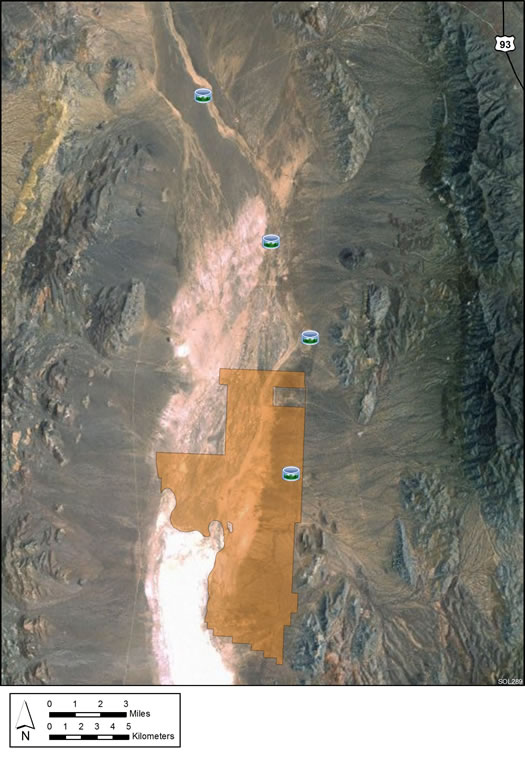The Approved Record of Decision for Resource Management Plan Amendments for Utility-Scale Solar Energy Development was issued on December 20th, 2024 — details are available on the BLM's Utility-Scale Solar Energy Development PEIS/RMPA webpage. Relevant information on the 2024 Western Solar Plan and the BLM's Renewable Energy Rule issued in July 2024, is in the process of being updated on this website.
| Nevada Variance Areas | Dry Lake Valley North SEZ |
 |
 |
The Dry Lake Valley North Solar Energy Zone (SEZ) is a designated leasing area (DLA) located in Nevada in remote undeveloped scrubland. The SEZ is located on BLM-administered land within the Ely District.
In the 2010 Draft Solar PEIS, the proposed Dry Lake Valley North SEZ had a total area of 76,874 acres (311 km2). In the 2011 Supplement to the Draft, the SEZ was reconfigured to eliminate 48,148 acres (195 km2), mainly the northern portion of the SEZ, to mitigate impacts on various resources, including impacts on sage-grouse and other wildlife, impacts on grazing, and impacts on military operations. In addition, about 3,657 acres (15 km2) of wetland and dry lake non-development areas within the remaining SEZ boundaries were identified. The remaining developable area within the SEZ is 25,069 acres (101.5 km2). No additional changes to the SEZ developable area were made in the 2012 Final Solar PEIS.
The Dry Lake Valley North SEZ is located in Lincoln County in southeastern Nevada. The SEZ is located in Dry Lake Valley and is framed by North Pahroc Range to the west, and West Range, Bristol Range, Highland Range, Ely Springs Range, Black Canyon Range, and Burnt Springs Range to the east. In 2008, the county population of Lincoln was 4,643, while adjacent Clark County to the south had a population of 1,879,093. The closest population centers to the SEZ are Pioche, located about 15 mi (24 km) to the east, and Caliente, located about 15 mi (24 km) to the southeast.

Vegetation in the Dry Lake Valley North SEZ is generally sparse, with large areas of low grasses and low-height scrubland. The SEZ occupies part of a dry lakebed.
Land within the SEZ includes roads, fences, livestock ponds, and a transmission line. The land is used primarily for BLM-authorized grazing with some off-highway vehicle use.
The surrounding land is rural and undeveloped. The Silver State Trail is a 240-mi (386-km) long multiuse trail through the mountain ranges that surround Dry Lake Valley that allows visitors access to these ranges.

The nearest major road is State Route 318, which is about 7 mi (11 km) to the west of the SEZ, while U.S. 93 is about 8 mi (13 km) to the south. A 69-kV transmission line intersects the southeast corner of the SEZ.
In the 2012 Solar PEIS, the BLM committed to establishing a monitoring and adaptive management strategy for each solar energy zone (SEZ). Through these strategies, the BLM will take an active role in the collection of baseline data for the SEZs.
The BLM has not yet begun the monitoring and adaptive management strategy for the Dry Lake Valley North SEZ. However, the BLM has conducted a pilot monitoring and adaptive management strategy for the Riverside East SEZ. In May 2016, the BLM released the Riverside East Solar Energy Zone Long Term Monitoring Strategy Final Report. The monitoring strategy document (PDF, 16.6 MB) is now available.
In the 2012 Solar PEIS, the BLM committed to preparing solar regional mitigation strategies (SRMSs) for the solar energy zones (SEZs). These regional mitigation strategies were intended to simplify and improve the mitigation process for future solar projects in SEZs.
On March 2, 2016, the BLM released the Regional Mitigation Strategy for the Dry Lake Valley North Solar Energy Zone – Final Report (PDF, 4.8 MB). The strategy identifies mitigation priorities and options in advance of development. The strategy takes into account the resource conditions of the land and regional trends informed by BLM's recent Rapid Ecoregional Assessments. The strategy was developed in collaboration with stakeholders to address key issues such as where and how mitigation may be achieved and the costs associated with doing so.
With IM-2019-018, the BLM established policy that compensatory mitigation could not be required as a condition for project approvals. However, with the issuance of IM 2021-038 on July 14, 2021, the BLM rescinded the previous IM-2019-018. The BLM expects to establish policies which are aligned with EO 13990, SO 3398, and the priorities of the Department. During this interim period offices should consider and implement compensatory mitigation on a case-by-case basis, in consultation with state office and national office program specialists and the Office of the Solicitor as needed.
The purpose of the Dry Lake Valley North model is to assess potential impacts associated with groundwater withdrawals to support solar energy development in the vicinity of the Dry Lake Valley North SEZ. This SEZ is located in Dry Lake Valley (Hydrologic Area 181).

The Dry Lake Valley North SEZ model is an update of the one-dimensional modeling performed as part of the 2012 Programmatic Environmental Impact Statement. The model is based on the Theis-Jacob method, and it relies on a thorough review of available hydrogeologic data and an assessment of the sensitivity of parameter values. Twenty years of high-, medium-, and low-demand groundwater pumping at the SEZ were modeled, producing estimates of the additional groundwater drawdown due to full build-out of the SEZ. The medium-demand case was selected for sensitivity analyses.
The Dry Lake Valley North SEZ model report has further information regarding its development and results.
The Dry Lake Valley North model file is a single Excel spreadsheet.
Note: Alterations to the Dry Lake Valley North Model could be made with the incorporation of new data regarding the hydrogeological framework and aquifer parameter values.
For questions regarding the Dry Lake Valley North model, please contact John Quinn.